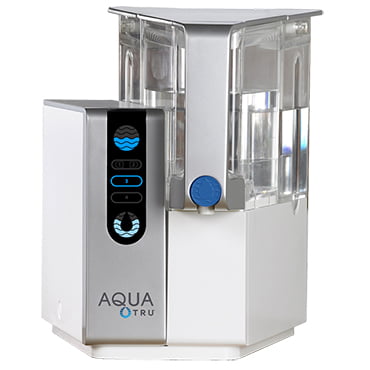Does Reverse Osmosis Remove Fluoride in Water?
Written by: Gene Fitzgerald // Last Updated: Sep 13, 2022
This page may contain affiliate links. If you buy a product or service through such a link we earn a commission at no extra cost to you. Learn more.
Cited as one of the most beneficial health achievements of the 20th century, water fluoridation is now under the radar. There is a looming question mark over the effectiveness of adding fluoride to drinking water.
Anti-fluoride activists claim that the world would be better off without additional fluoride in their water supply, thanks to the influx of safer dental health products. However, the U.S. water board is not quick to act.
Since the 1940s, municipalities in the U.S. have added fluoride to drinking water in order to help prevent tooth decay. Presently, about two-thirds of the population gets supplied with fluoridated water.
Although it’s true that fluoride helps strengthen the tooth enamel and reduces the chances of cavities in kids and adults alike, an excess of fluoride can have side effects.
If you, too, are worried about consuming excess fluoride, the logical course of action is to remove it using a home water filter. This short guide discusses how you can effectively do so using reverse osmosis water purification. Ready?
Key Takeaways
- Using reverse osmosis can remove fluoride from water supplies.
- In fact, reverse osmosis systems are among the most popular choice of home water purifiers for fluoride removal.
- The RO process can effectively remove 85-95% of fluoride content.
Can Reverse Osmosis Remove Fluoride?
In a nutshell: Yes, reverse osmosis can remove fluoride from water supplies.
Do All Reverse Osmosis Water Filter Systems Remove Fluoride?
Yes, all reverse osmosis systems, or RO systems, can remove fluoride from drinking water. However, the effectiveness of the filtration process depends tremendously on the proper maintenance of the unit.
How Much Fluoride Does Reverse Osmosis Remove?
All reverse osmosis systems are not made alike, and therefore they feature varying degrees of effectiveness when it comes to fluoride removal. On average, an RO system can remove between 85-95% fluoride.
No doubt, it depends on the quality of the RO membrane used, as well. For example, the AquaTru reverse osmosis system removes 93.5% fluoride (NSF-certified), while the Aquasana OptimH2O removes 95.7% (NSF-certified).
This should come as no surprise since RO water treatment is designed to remove up to 99.9% of hundreds of water contaminants including heavy metals, salts, and minerals.
With that said, RO systems are also the most popular choice for fluoride removal among all types of home water purifiers.
#1 RO System for Fluoride: AquaTru
- Our #1 Reverse Osmosis System for Fluoride and Overall
- Produces Pristine Drinking Water Fast
- 93.5% Average Fluoride Reduction, Also Removes 80+ Other Water Contaminants
- NSF-Certified: 42, 53, 58, 401, P473
- Installation-Free – Great for Renters
- Simple, Low-Cost Maintenance
- → All Details in Our Full Review
How Does Reverse Osmosis Remove Fluoride?
Reverse osmosis employs a semi-permeable membrane that has millions of tiny pores as small as 0.0001 micron in size. The pores are large enough to allow water molecules to pass through but so small that most impurities found in water are rejected, including fluoride.
How does the process work exactly?
High pressure is applied to the feed water once it enters an RO system. This forces the water through the RO membrane. Almost all contaminants are left behind. They remain in the leftover waster (wastewater) which flushes out of the system through a drain line.
By the way, due to their extremely small micron size, RO membranes are prone to fouling. What’s more, chemicals like chlorine can damage them severely. That’s why any reverse osmosis system employs multiple stages of pre-filtration, must commonly sediment and activated carbon filters.
The additional filter media pre-treats the water before it can pass through the membrane.
About Fluoride and Health Concerns
According to the American Dental Association, fluoride is added to tap water supplies at around 1 part per million.
Unfortunately, the problem with fluoridation of a water supply is that many people already receive more than their daily requirement of fluoride from other sources such as salt, milk, cookware, medications, toothpaste and other dental products.
When you drink fluoridated water, it enters your bloodstream and then gets stored in teeth and bones. Now, this is where it gets tricky.
In moderate amounts, fluoride has multiple health benefits. But when the amount of fluoride intake exceeds the daily requirement, it can do serious harm.
Here are some problems that can arise when you consume high amounts of fluoride over a long time.
Dental Fluorosis
Dental fluorosis is a condition that is characterized by changes in the appearance of the tooth enamel. It is caused by overexposure or overconsumption of fluoride during the first eight years of a child’s life.
Skeletal Fluorosis
Skeletal fluorosis is a bone disease and occurs due to excessive accumulation of fluoride in a person’s body. The painful condition causes joint stiffness and weakened bones.
In critical cases, the bone structure may change, and ligaments may harden up, resulting in restricted bone movement.
Neurological Problems
Some fluoride can also accumulate in brain tissue, especially in areas that are responsible for memory and learning. Over time, it can irreversibly damage the nervous system and cause insomnia, impaired overall mental wellbeing, etc.
Thyroid Problems
Fluoride also hinders the functioning of the thyroid gland. It decreases the concentration of T3 and T4 thyroid hormones while increasing TSH levels. Thus, the long-term effect of fluoride is an under-active thyroid in which functioning of the organ is subdued.
Fluoride Intoxication
Fluoride intoxication can only occur when a person consumes an extremely large amount of fluoride over a long period of time.
Historically, most incidents of intoxication occurred due to the swallowing of pesticides containing sodium fluoride.
On the other hand, accidental consumption of dental hygiene products is the cause of fluoride toxicity in modern times. Keep in mind fluoride intoxication is very rare and almost unheard of.
What Else Does Reverse Osmosis Remove?
Apart from fluoride, reverse osmosis can remove a wide range of harmful contaminants and impurities. In fact, RO water purification is one of the most effective ways to purify water at home.
Here is a list of the most common contaminants that a reverse osmosis water filter system can remove:
- Chlorine and chloramine
- Lead
- Chromium
- Copper
- Cadmium
- Arsenic
- Fluoride
- Radium
- Sulfate
- Nitrate and nitrite
- Phosphorous
- Pesticides
- Pharmaceuticals
- Volatile organic compounds (VOCs)
To clarify, reverse osmosis alone could not remove all these contaminants. But we must not forget the pre and post-filters that come with any RO system for home use. The combination of different filter media is what allows the filtration process to target many different types of substances.
What Is Not Removed By Reverse Osmosis?
If we consider RO alone, it is not entirely foolproof. For example, an RO membrane cannot be used to remove:
- Chemicals like pesticides and herbicides
- Chlorine
- Chloramine
- Disinfection byproducts
- Hydrogen sulfide
- …
Advantages and Disadvantages of RO Water Filtration
Reverse osmosis systems purify water down to the molecular level leaving almost only purified H20 behind.
Regardless, there are a few problems associated with these systems too. Here is what you can expect in terms of pros and cons.
Broad & Powerful Contaminant Removal
For now, you may only be interested in removing fluoride from your water, but an RO system can remove hundreds of impurities. As a result, your water will be a lot cleaner, and you will find an improvement in your overall health and wellbeing.
Better Tasting Water
If you prefer water that is tasteless without the flavor of chlorine and trace minerals, you’ll be glad to drink RO water.
Simple Installation and Maintenance
RO systems are generally easy to install and maintain. The different filter elements last between 6 months and 2-3 years before needing replacement. So, apart from replacing the pre-filters regularly, an RO system won’t take up a lot of your time.
Wastewater
Unfortunately, RO systems are highly wasteful. They send an average of 4 gallons down the drain for every one gallon of purified water.
Removes Healthy Impurities
And not only will you see your water bill creeping, but you will also find your water being deprived of essential minerals. This is the biggest problem associated with RO water. Some nutritionists even call it “dead”.
Consuming RO water for a long time may cause mineral deficiency if your daily intake is not met through other sources.
What to Consider When Choosing an RO System
So are all reverse osmosis systems equal? Not really.
Consider the following pointers before selecting one for your household.
System Type
Here are the two types of reverse osmosis water filtration systems available:
- Countertop and under sink RO systems: These are point-of-use filters that only treat water at one faucet or tap. Also read: Collection of the Best Point-of-Use Reverse Osmosis Systems.
- Whole house RO systems: Point-of-entry water filters treat every single drop of water that enters your home. If you are interested in a whole house reverse osmosis system, you can find the best ones here.
NSF Testing and Certifications
Always look for NSF/ANSI certifications or at least testing before buying.
Besides ensuring that a water filter works as advertised in regards to contaminant reduction rates, NSF certifications make sure it is made using high-quality materials only.
For reverse osmosis systems, it’s essential to check for NSF Standard 58. It addresses the minimum requirements for the reduction of a wide range of contaminants such as TDS, chromium 6, and lead.
Filter Process
Look at the additional filter stages aside from the reverse osmosis membrane. Do their meet your filtration requirements?
Water Demand, Pressure & Wastage
An RO system requires at least 40 psi of water pressure to push enough water through its membrane. If your feed water pressure is less than 40 psi, you will need a system with an inbuilt pressure pump.
Similarly, some RO systems produce up to 4 gallons of wastewater for every gallon purified. Others feature a 1:1 ratio. It’s wise to look for a system that is less wasteful.
Installation + Maintenance
Most reverse osmosis filter systems feature DIY installation that can help you save tons of money. Of course, you can still hire a licensed plumber to do the installation for you, but it adds up the costs considerably.
Besides, look for a system that features easy and tool-free replacements, so you don’t find yourself in trouble every few months.
Cost
Lastly, consider the initial price tag and annual maintenance cost before making a purchase.
In order to estimate maintenance cost, evaluate how often the filters need replacement and also check their price and availability.
If you have any thoughts about the question, does reverse osmosis remove fluoride, please don’t hesitate to leave a comment below!
Information provided on BOS is for educational purposes only. The products and services we review may not be right for your individual circumstances.
We adhere to strict editorial guidelines. Rest assured, the opinions expressed have not been provided, reviewed, or otherwise endorsed by our partners – they are unbiased, independent, and the author’s alone. Our licensed experts fact-check all content for accuracy. It is accurate as of the date posted and to the best of our knowledge.






